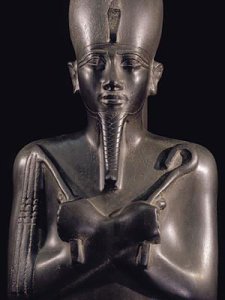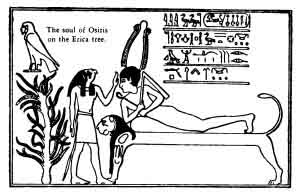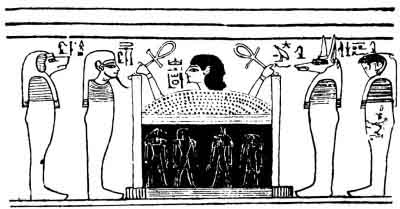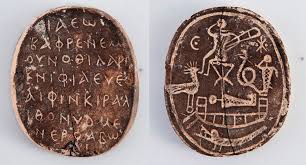|
Osiris

Aliases: Ausar
Location: Egypt
Cities: Abydos
Estimated Date: 2400s B.C. (or 3000s B.C.) - 500s A.D.
He was equated with Attis, Adonis, Dionysus and Orpheus by historians and theologians
The fifth-century B.C. historian Herodotus claims the name and rites of Dionysus came from an Egyptian seer and guesses that the rites originally came from Phoenicia. The first century B.C. historian Diodorus of Sicily said that the rites of Dionysus were taken by Orpheus from the rites of Osiris in Egypt and that only the names had changed. The first century B.C. statesman Cicero and the third-century A.D. Neo-Platonic philosopher Porphyry equated Dionysus with Osiris. The third-century A.D. theologian Hippolytus equated Attis, Adonis, Osiris and Bacchus (Dionysus) with each other.
Melampus, the son of Amytheon, cannot (I think) have been ignorant of this ceremony- nay [of sacrificing a hog], he must, I should conceive, have been well acquainted with it. He it was who introduced into Greece the name of Bacchus, the ceremonial of his worship, and the procession of the phallus. He did not, however, so completely apprehend the whole doctrine as to be able to communicate it entirely, but various sages since his time have carried out his teaching to greater perfection. Still it is certain that Melampus introduced the phallus, and that the Greeks learnt from him the ceremonies which they now practise. I therefore maintain that Melampus, who was a wise man, and had acquired the art of divination, having become acquainted with the worship of Bacchus through knowledge derived from Egypt, introduced it into Greece, with a few slight changes, at the same time that he brought in various other practices. For I can by no means allow that it is by mere coincidence that the Bacchic ceremonies in Greece are so nearly the same as the Egyptian- they would then have been more Greek in their character, and less recent in their origin. Much less can I admit that the Egyptians borrowed these customs, or any other, from the Greeks. My belief is that Melampus got his knowledge of them from Cadmus the Tyrian, and the followers whom he brought from Phoenicia into the country which is now called Boeotia.
Demeter has the same meaning among the Greeks as Isis amongs the Egyptians: and, again, Kore and Dionysus among the Greeks the same as Isis and Osiris among the Egyptians. Isis is that which nourishes and raises up the fruits of the earth; and Osiris among the Egyptians is that which supplies the fructifying power, which they propitiate with lamentations as it disappears into the earth in the sowing, and as it is consumed by us for food.
Such Egyptians as possess a temple of the Theban Jove, or live in the Thebaic canton, offer no sheep in sacrifice, but only goats; for the Egyptians do not all worship the same gods, excepting Isis and Osiris, the latter of whom they say is the Grecian Bacchus...
Therefore, he says, when, on the people assembling in the theatres, any one enters clad in a remarkable robe, carrying a harp and playing a tune (upon it, accompanying it) with a song of the great mysteries, he speaks as follows, not knowing what he says: "Whether (thou art) the race of Saturn or happy Jupiter, or mighty Rhea, Hail, Attis, gloomy mutilation of Rhea. Assyrians style thee thrice-longed-for Adonis, and the whole of Egypt (calls thee) Osiris, celestial horn of the moon; Greeks denominate (thee) Wisdom; Samothracians, venerable Adam; Haemonians, Corybas; and them Phrygians (name thee) at one time Papa, at another time Corpse, or God, or Fruitless, or Aipolos, or green Ear of Corn that has been reaped, or whom the very fertile Amygdalus produced--a man, a musician." This, he says, is multiform Attis, whom while they celebrate in a hymn, they utter these words: "I will hymn Attis, son of Rhea, not with the buzzing sounds of trumpets, or of Idaean pipers, which accord with (the voices of) the Curetes; but I will mingle (my song) with Apollo's music of harps, 'evoe, evan,' inasmuch as thou art Pan, as thou art Bacchus, as thou art shepherd of brilliant stars."
He is a shepherd and carries a shepherd's crook-staff

In the Book of the Dead, which is based on an ancient literary tradition stretching back to 2400 B.C., Osiris is called “the Shepherd”, like Dumuzi, Adonis and Attis. Like most pharaohs, Osiris was portrayed with a shepherd's crook like that of Dionysus and Orpheus in one hand a flail in the other.
He is placed in a box and given to the netherworld

Osiris is locked in a wooden sarcophagus by his evil brother Set and set down the Nile similar to the story of Adonis being locked in a chest when he was sent to the netherworld.
In death, he is enclosed in a tree

Osiris' sarcophagus sails down the Nile and then gets embedded in a tree at Byblos, the Phoenician city Pseudo-Lucian said that the Adonis cult originated from, where Isis finds it. The tree is referred to in the Djed Column as the Tree of Life.
He rises from the dead

Set scatters Osiris’ body into 14 places but Isis and Nephtys find all the pieces except the phallus, which was eaten by a fish, so Isis fashions a golden replacement and sings a song to resurrect him, somewhat similar to how Tammuz was raised by women ritually mourning for him. The second century theologian Clement of Alexanderia repeats a myth about how after Zagreus Dionysus was killed by the Titans, the twin sons of the volcano god Hephaestus deposted Zagreus’ genitals in a sacred cave on the isle of Samothraki, establishing the Samotrakian Mysteries. Bart Ehrman tries to say that Osiris has a “rejuvenation” rather than a resurrection so that he “does not—decidedly does not—return to life” (228), but Osiris fathered Harpocrates with Isis after his death, so he obviously did not stay in the underworld. His death and resurrection were also associated with the lunar phases.
His followers are “born again”
A hymn to Osiris says that he “giveth birth unto men and women a second time”, similar to the “born twice” motif of Dionysus and the Gospel of John.
His death is ritually mourned as a symbol of the seasonal change
...for the shutting up of Osiris in the coffer probably means nothing else than the concealment and disappearance of the water: for which reason they say that Osiris vanished in the month Athyr, at which time, the Etesian winds having entirely ceased, the Nile recedes, and the country is laid bare, and night lengthening, darkness is increased, and the power of light wastes away and is subdued, and the priests also perform other dismal rites, and cover a gilt ox with a black veil of linen; and so exhibit it in mourning for the goddess (for they consider the ox as the animated image of Osiris) for four consecutive days, beginning with the seventeenth. For the things mourned for are four in number: first, the Nile failing and shrinking; secondly, the Northerly breezes entirely extinguished through the Southerly getting the upper hand; thirdly, the day growing shorter than the night; and in addition to all this, the exposure of the land, coupled with the stripping of the trees, which cast their leaves at that very time.
His blood is associated with wine
In an Egyptian papyri, a magic spell is cast by drinking a cup of wine symbolically linked to the blood of Osiris in order to enter into a spiritual union of love between Osiris and Isis.
He was worshipped in mystery cults
He has represented the sovereignty of Jupiter as more majestic on account of his knowledge and wisdom, being at the same time the more ancient of the two. And I am of opinion that the happiness of the eternal life which is the attribute of God consists in his not being ignorant of future events, in virtue of his knowledge, for if the knowing and understanding of events were taken away, then immortality becomes not life but duration....
For which reason, of the Muses at Hermopolis they call the foremost one “Isis,” and “Justice-Wisdom”, as hath been stated; and they show the divine mysteries to such as be truly and rightfully styled “carriers of sacred things”, and “wearers of sacred robes”: these are they that carry in the soul, as it were in a copper, the sacred story respecting the gods that cleanses the recipient from all superstition, and magical follies: and who wrap themselves up, sometimes in things black and dusky, at other times bright and conspicuous—darkly showing forth the same notions as regards opinion of the gods as are expressed with respect to the sacred vestment.
He acts as judge of the afterlife
The Book of the Dead, dated to the 1500s B.C., provided advice and magical spells for succeeding in the judgment of the divine council where the initiate's soul was weighed against the Feather of Truth to determine whether it was to be devoured or taken to Osiris to share in the afterlife. The first century B.C. historian Diodorus of Sicily said that the “figments of imagination” about a happy or toremented afterlife were imitations of the funerary rites of Osiris first brought to Greece by Orpheus.
He is depicted on an amulet linking Yahweh with Ra

1,500-Year-Old Amulet from Cyprus shows Osiris as a mummy on one side
and mentions Yahweh and Ra together on the other side
An amulet from Cyprus dated to the 500s A.D. portrays a mummy that scholars identify as Osiris along with other Egyptian religious symbols on one side and an inscription written as a palindrome saying, “Iahweh the bearer of the secret name, the lion of Re secure in his shrine.” The lion was an ancient symbol of Judah as well as the totem animal of Dumuzi's wife Inanna and were typically more associated with Egypt and the Sinai in the south where lions were more prevalent as opposed to the bull totem that was more prevalent in Syria and Canaan in the north and in Mesopotamia.
Next God: Serapis
The Dying-and-Rising Gods
Leave Comments Here
|

